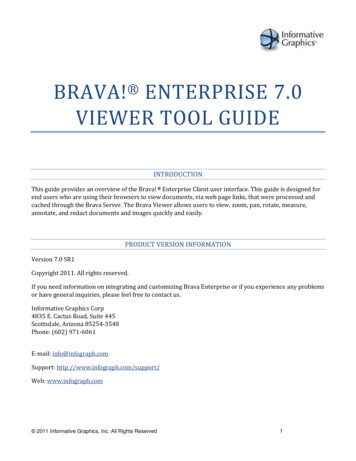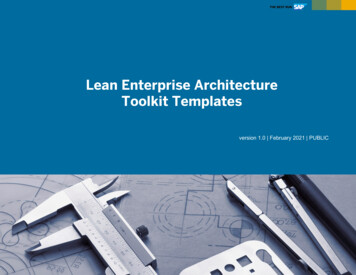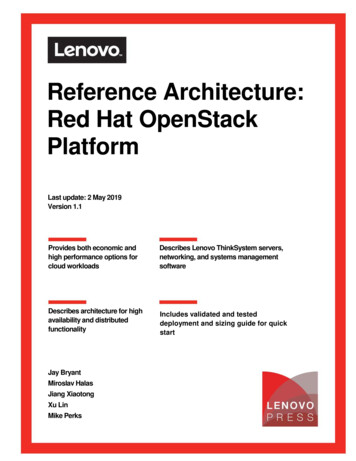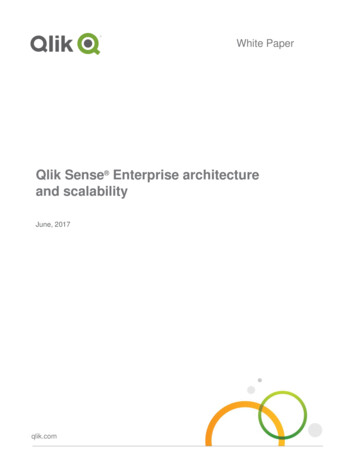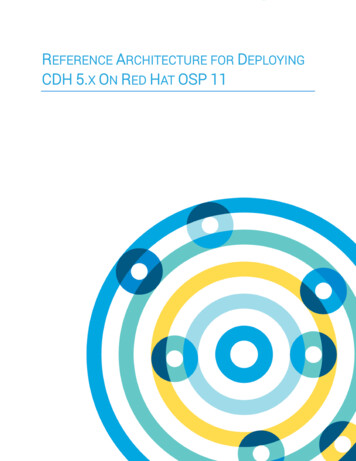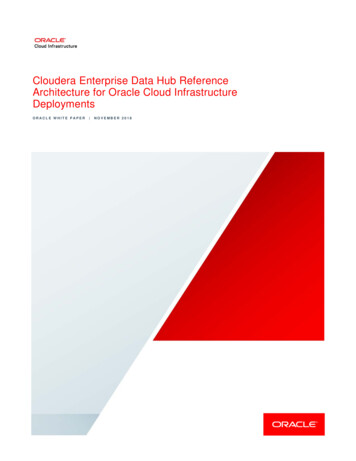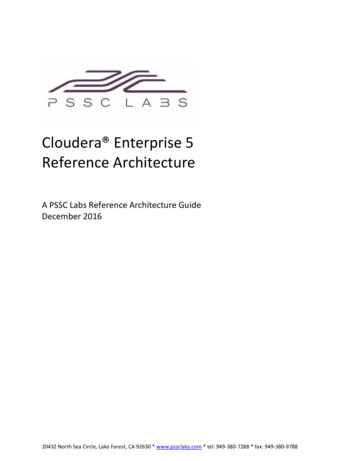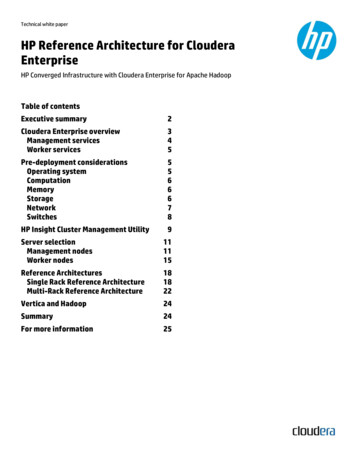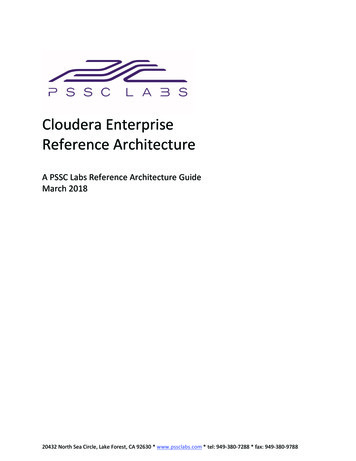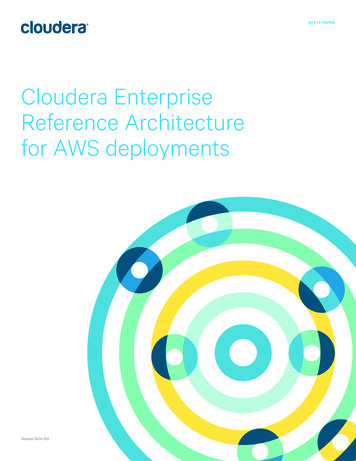
Transcription
Buschle et al.Tool support for the Predictive, Probabilistic Architecture Modeling FrameworkThe Enterprise Architecture Analysis Tool – Support forthe Predictive, Probabilistic Architecture ModelingFrameworkPontus JohnsonMarkus BuschleIndustrial Information and Control SystemsIndustrial Information and Control SystemsKTH Royal Institute of TechnologyKTH Royal Institute of ram ShahzadIndustrial Information and Control SystemsKTH Royal Institute of Technologykhurrams@ics.kth.seABSTRACTThe business of contemporary organizations is heavily dependent on information systems. Businessprocesses and IT are interwoven and numerous technologies are in use. How the involved systems affecteach other or impact the organizations’ business domain is often uncertain, thus decision-makingregarding information technology is challenging.Enterprise architecture (EA) is a holistic, model-based management approach. Many of the available EAsoftware tools focus on documenting and have limited analysis capabilities. In this article, a tool for EAanalysis is presented, supporting the analysis of properties such as business fit, security, andinteroperability. The tool is implemented to support the Predictive, Probabilistic Architecture ModelingFramework to specify and apply assessment frameworks for performing property analysis on EAmodels.KeywordsEnterprise Architecture Analysis, probabilistic inference, system properties, software toolINTRODUCTIONThe management of organizations and their IT systems requires frequent decision-making. Thesedecisions can, for example, be whether an existing system, in order to provide the performance neededfor future services, should be replaced, upgraded or kept as it is. Another decision might be whether twoapplications should be integrated, used in the same fashion they have been used until now or whether theprovided services should be outsourced.In the making of machines, vehicles and buildings, the design technology CAD (Computer-aidedDesign) (Eastman 1999) is commonly used, i.e. models of the artifacts that will be created. Thesemodels provide a great benefit: it is easy to perform calculations of how the artifacts would behaveinstead of testing them empirically. Empirical testing such as crash tests is expensive and timeconsuming. Based on CAD calculations the right material for a given purpose can be identified or anoptimal setup for a certain construction can be chosen.One common approach for IT management, enterprise architecture (EA), is to create models of ITsystems and the processes they support (Ross et al. 2006)(Lankhorst 2009). Similar to CAD tools,current EA tools support the creation of models representing organizations and their IT. However, theavailable EA tools generally only support the creation of descriptive models (Matthes et al. 2008) andlack advanced analysis capabilities. Investigations of system availability or how well an organization isProceedings of the Nineteenth Americas Conference on Information Systems, Chicago, Illinois, August 14-17, 2013.1
Buschle et al.Tool support for the Predictive, Probabilistic Architecture Modeling Frameworkcapable of fulfilling its goals are generally not possible, neither is it possible to analyze cyber securityaspects to identify vulnerabilities. Following the CAD analogy, current EA tools are comparable to CADtools without the ability to analyze the design i.e. without the functionality to simulate crash tests,calculate stability of buildings or investigate the performance of engines.Reports such as the Chaos report (The Standish Group International 2009) show that IT projects tend toexpand in time or be more expensive than expected initially. This is often caused by unforeseenproblems during the performance of the projects. Therefore EA tools capable of doing analysis would beuseful to analyze the impact of changes already during the design stage and to help make the rightdecisions.Within the process of decision-making, considering how different properties are related to each otherand making trade-offs between those properties is often necessary (Närman et al. 2013). For instance,security is much improved by adding an intrusion detection system, but it may have a negative impacton performance.Compared to mechanics of materials, the theories of EA are not as absolute, and thus, the uncertaintiesin these theories have to be taken into consideration in the analysis (Lagerström et al. 2009). Anotherchallenging aspect is that collected information might be outdated, incomplete or even incorrect.In this article, it is justified that there is a need for an EA tool to perform advanced analysis. Thisanalysis is conducted based on the Predictive, Probabilistic Architecture Modeling Framework (P2AMF)(Johnson et al. 2013), supporting the creation of models and the calculation of their properties. Theframework allows considering the structure of the models and dependencies between modeled elements.A tool that, compared to other approaches, has the following notable characteristics is presented1: It supports analysis of various analysis properties and is not limited to a predefined set ofhardcoded analysesIt considers dependencies between properties of the analyzed EAIt handles incompleteness and uncertainty in the EA as well as in the theoretical foundations.Considering the CAD analogy once again, the presented tool is a CAD tool for EA completely coveringthe use cases of conventional CAD tools. Models can not only be created and manually studied, but alsoanalyzed. The tool helps identifying architecture scenarios that perform well with regard to consideredanalysis properties.The rest of this article unfolds as follows: section 2 discusses related work. Next a method for EAanalysis is described. In section 4 the underlying theory of the tool’s calculation engine, P2AMF, isexplained. Section 5 describes the architecture of the presented tool. A dedicated section describing howthe tool supports P2AMF follows. Section 7 illustrates a case study applying the tool. Finally section 8concludes the article and outlines future work.1The tool can be downloaded at http://www.ics.kth.se/eaatProceedings of the Nineteenth Americas Conference on Information Systems, Chicago, Illinois, August 14-17, 2013.2
Buschle et al.Tool support for the Predictive, Probabilistic Architecture Modeling FrameworkRELATED WORKSeveral well-known EA frameworks exist. The perhaps most well-known one is the model taxonomy inthe Zachman framework (Zachman 1987). Other frameworks focus more on a specific metamodel.Metamodels define the allowed content and graphical representations of the models. Somerepresentatives are DoDAF (Department of Defense 2007) and ArchiMate (Lankhorst 2009). TOGAF(The Open Group 2008) emphasizes the method of EA and also features a metamodel. All thoseframeworks share a focus on the descriptive capabilities of EA (Kurpjuweit and Winter 2007).Some of the most well-known EA tools include Rational System Architect (IBM 2013), ARIS ITArchitect Designer (Software AG 2013), BiZZdesign Architect (BiZZdesign 2013), the Trouxtransformation platform (Troux Technologies 2013) and planningIT (alfabet AG 2013). These toolsgenerally support one or several of the previously mentioned frameworks and metamodels.Although the tools often possess some analysis capabilities, such analyses are qualitative, based onvisualizations, and do not include calculations of model properties. E.g. it can be investigated which ITsystems support a selected business process, how many applications that read a certain data object orwhich roles are assigned to a specific department.Within those tools EA models usually cannot be analyzed with respect to properties such asperformance, business fit, availability or cyber security. Common EA tools allow relating entities,indicating that a certain concept e.g. is a specialization of another one, is composed of several conceptsor is the predecessor of a modeled entity. Within the tools, relations visually indicate that the realconcepts, which the model entities are meant to reflect, have a connection. A certain organizational rolemight be a specialization of another one, a business process might consist of several sub-processes, or anactivity might be the predecessor of another one. However within the tools the relationships are not usedto analyze the causal impact of properties of the modeled entities on each other. The tools do not inferthe state of a considered attribute based on other attributes that are impacting it. Third, as well-knownEA tools do not focus on advanced analysis capabilities, the tools do not cover the aspect of incompletemodels. Those tools only consider elements that explicitly have been modeled. The fact that the tool usermight not know all the details for creating a holistic model or might not be sure whether some aspectsneed to be described is not covered. Finally well-known tools expect the models to be correct in everydetail. A user typically cannot express that he or she is unsure about the value of a certain attribute orrelationship.Abacus (Dunsire et al. 2005) however, offers complex analysis capabilities. It allows investigating EAmodels with respect to assessment properties such as performance, agility, and reliability. This is doneusing discrete-event and Monte-Carlo simulation. Abacus lacks two characteristics of the tool presentedin this article. First, Abacus does not allow incorporating uncertainty in the analysis. Second, Abacushas a fixed set of analysis capabilities; the tool presented in this article allows the user to specify new ormodify current analysis theories.The tool providing the closest functionality compared to the one presented in this article is its ownpredecessor, the Enterprise Architecture Analysis Tool presented in (Buschle et al. 2010). This tool is aprototype with poor usability. It was implemented to support Probabilistic Relational Models (Koller1999), a formalism with limited capabilities for considering structural aspects. Analyzing models underconsideration of if and how objects are related is difficult to realize, as every possible combination ofobjects needs to be considered separately. The presented tool addresses this weakness by supportingP2AMF, explained in section 4.Proceedings of the Nineteenth Americas Conference on Information Systems, Chicago, Illinois, August 14-17, 2013.3
Buschle et al.Tool support for the Predictive, Probabilistic Architecture Modeling FrameworkFigure 1 The supported enterprise architecture analysis methodENTERPRISE ARCHITECTURE ANALYSISSeveral methods exist for performing analysis of enterprise architecture models for decision support.The presented tool supports the method presented in (Johnson and Ekstedt 2007). This method isdepicted in Figure 1. First, an extended metamodel is created. Following the UML nomenclature, theauthors refer to it as class model. This class model has an extended meaning. It describes not only theallowed content of the models, but also how characteristics of the model impact each other with regardto chosen criteria for architecture analysis. For those characteristics of the model general data describingthem are included too. In the second step, scenarios of interest are identified. Each scenario is describedas an object model instantiating the previously created class model. For a particular scenario onetypically wants to replace general data with specific information, for some or all attributes that are partof the model. This is done in order to provide a more specific description. In the nomenclature ofprobabilistic inference, such instance-specific data is called evidence. In the final step, analysis,quantitative values of the models' quality attributes are inferred and the results are visualized.The aim of this article is to address the challenge of creating a tool tailored specifically for EA analysissupporting decision-making. The primary use case for the tool, and the one portrayed in this article, istherefore to cover the method depicted and described above.THE PREDICTIVE, PROBABILISTIC ARCHITECTURE MODELING FRAMEWORKThe Predictive, Probabilistic Architecture Modeling Framework (P2AMF)(Johnson et al. 2013) is anextension of OCL (Object Management Group 2010) for probabilistic assessment and prediction ofsystem properties. The main feature of P2AMF is its ability to express uncertainties of objects, relationsand attributes in UML-models and perform probabilistic assessments incorporating these uncertainties.A typical usage of P2AMF would be to create a model for predicting, e.g., the availability of anapplication. In P2AMF, two kinds of uncertainty are introduced. First, attributes may be stochastic.When attributes are instantiated, their values are expressed as probability distributions. Second, theexistence of objects and relationships may be uncertain. It may, be the case that one no longer knowswhether a specific server is still in service. This is a case of object existence uncertainty. SuchProceedings of the Nineteenth Americas Conference on Information Systems, Chicago, Illinois, August 14-17, 2013.4
Buschle et al.Tool support for the Predictive, Probabilistic Architecture Modeling FrameworkFigure 2 The Class Modeleruncertainty is specified using an existence attribute E that is mandatory for all classes (here using theconcept class in the regular object-orientedoriented aspect of the word), where the probability distribution of theinstance myServer.E might be:P(myServer.E) 0.8i.e. there is an 80% chance that myServererver still exists. It might also be uncertain whether myServer is stillserving a specific application, i.e. whether there is a connection between the server and the application.Similarly, relationship uncertainty is specified with an existence attribute E on the relationships.The probabilistic aspects are considered in a Monte-Carlolo fashion: For each iteration, the stochasticvariables are instantiated with instance values according to their respective distribution. This includesthe existence of classes and relationships, which are sometimes instantiated, sometimes not, dependingon the distribution. Then, each of the P2AMF statements is transformed into a proper OCL statement andcan be evaluated. How this is realized in the tool is described below.THE ENTERPRISE ARCHITECTURE ANALYSISALYSIS TOOLThis and the following section constitute the contribution of this article. They describe a toolimplemented to support EA analysis for decision support. In order to realize this tool,tool the workflow ofProceedings of the Nineteenth Americas Conference on Information Systems, Chicago, Illinois, August 14-17,, 2013.2015
Buschle et al.Tool support for the Predictive, Probabilistic Architecture Modeling FrameworkFigure 3 The described examplethe previously described method for EA analysis is covered. Furthermore P2AMF is supportedsuppoto createclass and object models and analyze the latter ones.The presented tool is implemented in Java using the Eclipse rich client platform. To provide themodeling facility the Eclipse Modeling Framework (EMF)(Steinberg et al. 2008) is used and extended.The tool is separated into two components, the Class Modeler and the Object Modeler,odeler, to be used in thisorder. The Class Modeler allows specifying an assessment framework (cf. the left part of Figure 1) interms of classes, their attributes and the relations between them. Figure 2 contains a screenshot of theClass Modeler. A canvas for the creation of class models accounts for the largest part of the userinterface. P2AMF derivations can be specified in the lower part. To the right the defined classes withtheir attributes are shown and a graphical outoutline allows navigating through large models.In case of an availability analysis the classes Infrastructure function and Node might be defined amongstothers. They might be related to express that infrastructure functions typically are assigned to Nodes.The attribute availability might be added to both classes expressing that the criteria of analysis isavailability. Thereafter a P2AMF derivation might be specified expressing that the attribute availabilityof the Infrastructure function class depends on the availability of the assigned Node classes. For otherattributes, such as the Node.availability.availability attribute, initial probability distributions might be specified.Since these initial distributions are given on the class level, they represent the whole population ofconsidered Nodes. Later, as the class model is instantiated, these estimates can be updated with instancespecific data. The example is depicted in Figure 3. Class models are saved as ecore files using the EMF.Once a framework has been specifiedfied it can be loaded into the Object MModeler.odeler. Figure 4 contains ascreenshot of the Object Modeler. This component supports the application of the framework (cf. themiddle part of Figure 1). The Objectbject Modeler allows instantiating the classes that have been defined inthe framework into objects and providing evidence for specific attribute valuesvalues. By relating objects toeach other a model of the scenario of interest can be created. Using the framework outlined in theprevious paragraph a particular Infrastructurenfrastructure function Read database might be related to a specificNode Database server. For the DDatabase server attribute availability evidence might be providedspecifying that the considered server is knowknown to have an availability of 99.993993 % (cf. Figure 3). OnceProceedings of the Nineteenth Americas Conference on Information Systems, Chicago, Illinois, August 14-17,, 2013.2016
Buschle et al.Tool support for the Predictive, Probabilistic Architecture Modeling FrameworkFigure 4 The Object Modelerthis model is in place, the Object MModeler allows calculating the attribute values included in the objectmodel (cf. the right part of Figure 1).). Thereby sampling according to P2AMF is performed.performedIn the example the attribute availability of the Read database Infrastructurenfrastructure function is calculated basedon the values provided for attribute availability of the Database server. How this exactly is done is thecontent of the following section. Once the sampling is completed the inferred attribute values arevisualized (cf. again the rightt part of Figure 1).The user interface looks similar to the one of the Class Modeler. Again, in the center a canvas for thecreation of models, here object modelsmodels,, can be found. Properties of the modeled objects can be set usinga tabularlar structure located to the right. Additional information regarding the created model or theperformed analysis is visualized in the lower part. Finally the left part allows consideringconsideralreadymodeled objects and navigating through the model.2SAMPLING ACCORDING TO THE P AMFThis section explains how inference is performed in the tool. The authors of P2AMF (Johnson et al.2013) are not specific on how this should be realized. In the tool three sampling algorithms,algorithms to infer thevalues of the attributes that are part of the created model, are implemented:: forward sampling, rejectionrsampling and Metropolis-HastingsHastings samplingsampling, each having advantages and disadvantages.Proceedings of the Nineteenth Americas Conference on Information Systems, Chicago, Illinois, August 14-17,, 2013.2017
Buschle et al.Tool support for the Predictive, Probabilistic Architecture Modeling FrameworkAs described above, the user starts the sampling functionality as soon as the object model describes thescenario of interest. The P2AMF object model is sampled to create a set of deterministic object models.This is done considering the probability that a certain object is part of the created object model and thata given relationship is contained in that object model too. Therefore the ex
The Enterprise Architecture Analysis Tool – Support for the Predictive, Probabilistic Architecture Modeling Framework Markus Buschle . Abacus lacks two characteristics of the tool presented in this article. First, Abacus does not allow incorporating unc

